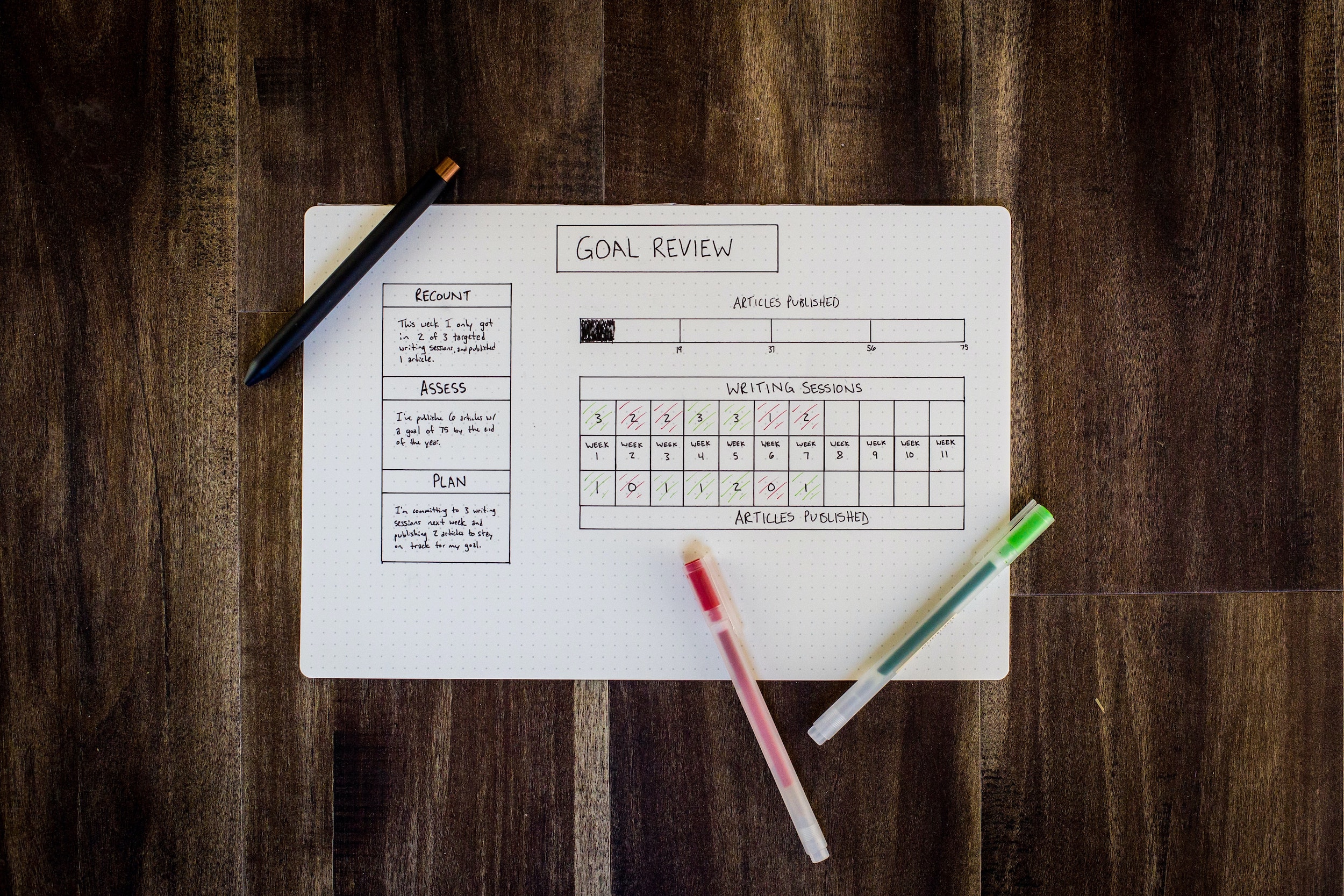A Guide to Tackling Overwhelming Goals
Share
Reading Time: 17 minutes








Do you ever have so much to do that you just do nothing? Instead of cleaning up the house and taking care of yourself, you clam up and stay firmly planted on the couch, overwhelmed by the sheer weight of the goals you have to accomplish.
Whether these goals are work-related or tied to your personal life, if they’re large and looming, they can turn us languid, making it a real challenge to tackle them head-on… and making it nearly impossible to balance the rest of life on top of it, too.

These big, overwhelming goals have existed since the beginning of time… they’re no anomaly. The cavemen sat in an asinine state with the challenge of making their food edible (enter: the discovery of fire) and the early farmers survived with the goal of making it through winter. In modern terms, whether it’s getting that raise at work, writing the book you’ve always said you would start, or even getting in shape, it seems like there is always some seemingly unattainable objective dancing in front of us, with no clear direction of how to get there.
In cases like this, it’s easy to become inundated. In fact, the natural reaction is to give up or justify inactions in some ridiculous way. These goals can become all-consuming, leading tasks fall to the wayside and turning daily responsibilities to mush. Suddenly, a job as simple as washing the dishes seems impossible because you’re trying to process how it will fit in with the million other things you should be doing to meet your goal.
In this article, I walk you through my modus operandi to tackle overwhelming goals head-on and break them down so that they can actually be accomplished. Beyond just accomplished, I show you how to manage these goals so that they don’t become a disruptive part of your everyday life.
Rather than letting these overwhelming goals fill you with dread and anxiety, use these tips and tricks to turn them on their head and make them feasible, rather than continuing to wait for them to magically accomplish themselves.
How to Break Down Overwhelming Goals
In the most simple terms, big goals are overwhelming. When you have this giant, daunting goal on the horizon, it can be challenging to picture ever achieving said goal… I mean, how do you even start?
We all have goals like these in our life. Maybe you want to earn $100,000 in a year; perhaps you want to develop a new app… Maybe this overwhelming goal of yours is to learn how to do a handstand or lose a few pounds.
No matter what the specific goal is, if it’s staggering in size it can turn into a huge battle to even know where to begin.

I know for me when it comes to design work, goals become overwhelming quickly. It’s easy to look towards the future at a set end result, but how do you actually get there? Since there’s seldom a clear pathway from Point A to the Finish Line, it’s important to learn how to break down overwhelming goals to become more manageable and ultimately, achievable.
When you can break down overwhelming goals, you’ll spend less time hung up on the enormity of the task and more time actually accomplishing what needs to get done.
So how exactly do you do this?
Start with The Big Picture
The first part of breaking down overwhelming goals is fairly straightforward: start big. What’s the overall goal? What do you hope to accomplish?
By determining this clearly with no room for confusion, you can see what you’re really working with. Don’t become obsequious to your goal. Rather, lay it all out on the table, scrawl out the gigantic goal so that it’s perfectly clear… Once it’s all hanging out, you can start to think about tackling it.
Starting big is crucial because oftentimes we have this giant goal floating around in our heads, but what’s in our mind isn’t actually specific enough to be accomplished. When goals are abstract like “make a ton of money”, “get new clients”, or even “lose some weight” it’s easy to call it quits when you’ve gotten “close enough”. Since there’s no set metric or standard related to these theoretical goals, who’s to say if you’ve accomplished them or not?

But if you can clearly spell out exactly what this giant overwhelming goal is, in the most specific and simple terms possible, there will be no grey areas about what you’re hoping to achieve. This revamps the goals from above into something like “make $100,000”, “land 6 new clients”, and “lose 15 pounds”.
After figuring out a precise goal, tack a time frame onto it. When you understand that there’s a set amount of time to accomplish something, you add in an urgency factor. Plus, when you give yourself a clear big picture, it helps you to iron out the details to actually turn this goal into a reality.
We can change the goals above one more time into something like: “make $100,000 in a year”, “land 6 new clients in 10 months”, and “lose 15 pounds in 15 weeks”. Since these goals are narrowed down to the point where there’s no room for misinterpretation, you know exactly what you’re working with and can devise an appropriate plan of attack.
Create High-Level Subgoals
So you’ve got your big, overwhelming goal ironed out… what’s next?
Now’s the chance to break things down even further into what I like to call “high-level subgoals.” These subgoals are still big and mighty but without the stultifying effect of the larger goal at hand.
Let’s run with the $100,000 example from above.
Say I want to make $100,000 in a year from my freelance design work. That’s a pretty hefty goal and overwhelming, to say the least. But let’s take the chance to break this down into high-level subgoals to see what we’re really working with.
Since I’m running on a year’s time span, I can break down my giant $100,000 goal into months. If I want to make $100,000 in 12 months, that means that I need to make about $8,334 each month.
There are 12 subgoals right there!
Instead of having to focus on the big picture of $100,000, I can set my sights on a more manageable (albeit still lofty) eight grand a month. If I want to take things a step further, I can break down my subgoals to a weekly or even daily basis.
To achieve this goal of $8,334 per month, that means I would need to make just under $2,000 per week, which brings me to a grand total of $384 per day (excluding weekends and holidays of course – let’s be realistic, people).
That leaves me with a solid starting point to work around. Instead of having that overwhelming $100,000 figure looming overhead, I can aspire to make $384 daily.
This subgoal method can be applied to any overwhelming goal! If you want to lose weight, break it down by how many pounds you’ll have to lose each week. If you want to sign more clients, break it down by the exact number of clients you want to sign each month. You can go on and on until your giant goal is nothing more than a handful of subgoals waiting to be attacked one by one.
What Will Help You Accomplish Subgoals?
After hacking away at your overwhelming goal until it’s in a more appetizing state, you’ll have to make a plan of action to help you accomplish your subgoals. Although they’re more innocuous this time around, you’ll still need a mode of transportation to edge you closer to the Finish Line.
Let’s jump back to the $100,000 example.
Once you’ve broken down this lump sum into pocket cash, you can break it down one more time until you’re left with $48 per hour. Making just under $50 per hour every day will get you to that $100,000 marker after a year. Okay great, but how to get this $48 per hour…
Well, since you know how much you want to be making, you can start to look for clients willing to pay you that much. That’s a good starting point. How else can you accomplish this goal? Are you even qualified to make that much?

Maybe this figure is a bit lofty, so you need to study up, learn new skills, build out your portfolio, and start marketing yourself. Maybe this is a chance to refine your resume or touch up your website to put your best foot forward and rope clients in. Perhaps it’s learning one new thing about your industry each week or practicing new software to round out your expertise.
These may seem like modicum details, but it’s the culmination of minute brushstrokes that create a full picture.
Regardless of what your goal is, layout some factors that can help you reach your subgoals. How can you get from Point A to Point B and then eventually to the finish line? This is the chance to invest in yourself and set up success down the road.
If you want to gain new work each month, this may mean reaching out to 20 prospective clients in that timeframe. If you want to lose one pound every week, maybe this means going to the gym every single day.
Whatever your subgoals are you can bet there will be several ways for you to get there. It may not always be pleasant or pretty, but this is the work that really counts and will ultimately drive you within reaching distance of your overwhelming goal.
What About More Abstract Goals?
If you’re reading this and thinking “great, but my goal isn’t financial and doesn’t have a number attached to it,” I hear you! And the best part is, this method applies to any kind of overwhelming goal you may have.
On a personal note, my mom has been paralyzed for the past 6 years and I’ve spent a lot of time working with her to set up specific health goals. One of her greatest desires was to have enough mobility to be able to drive a handicap accessible car again so we made this a big overwhelming goal to work towards.
We started by breaking it up into high-level subgoals like regaining mobility and having a healthier diet. From there, we could narrow them down even further by creating tasks like daily physical therapy and exercise, along with three healthy meals a day.

While her goal didn’t have any numbers tacked on to it, my mom had an idea of what she wanted to achieve and knew that she wanted it to happen as soon as possible. This allowed us to create a plan of action, the same way I would for any other overwhelming goal, and execute the smaller tasks needed to make it happen.
Regardless of what overwhelming goal you have in your mind, you can use this strategy to accomplish them. Say you want to learn how to do a handstand. You have to work on your fitness, improve your flexibility, practice against a wall until you can eventually practice on your own. While this is still more abstract than making $100,000, there are set actions that can be taken to achieve it.
Overwhelming goals are like doing a puzzle… there are lots of moving pieces all over the place at the beginning, spread across the table the same way your goal may be scattered throughout your mind. It’s about sorting through the pieces, organizing them by shape or color, and then putting them into place one by one. Only then will you be able to find a place for each piece and reveal the full picture.
Action Items for Reaching Your Goals
These goals are ubiquitous and will appear in your life more than once. As they pop up again and again and grow larger in size, there’s no need to become inundated every time they materialize. Rather, have a set plan of action of how you’re going to tackle them using the items on the list and before you know it, you’ll be on track to achieve your overwhelming goal.
1. Jot Down a List
One of the top tips I have for achieving overwhelming goals is to jot down a list. Make a list of your subgoals and a list of what you’ll need to do to achieve them. Keep on writing lists every day (I write my to-do list first thing each morning), laying out a plan of action for what you have to do to get one step closer to your goal.

Creating lists satiates our need for order. Take it from me, queen of needing everything in an orderly fashion. I literally have notebooks full of lists, and I swear it’s the best way to actually get things done.
There are also plenty of studies that have proven that the physical action of checking things off from a to-do list will create the momentum and motivation to tackle other things. When you make a to-do list, your brain actually craves for the items to be crossed off, giving you the push needed to take steps closer to your goal.
2. Start Small
Even when you break down your overwhelming goal into subgoals, and then into further actions from there, you’ll still need a starting place to actually get the ball rolling… Start small! Don’t immediately jump at the larger tasks that need to get done. Build up to them by completing the smaller tasks first.
Start where you can. Get up first thing in the morning, make your bed, take out the trash, get in the shower, do the dishes. Even if the tasks aren’t directly related to your big goal, starting small is a great way to help you feel accomplished. And once you start to feel accomplished, you can take that mindset and apply it to the bigger fish you have to fry.
3. Know Your Motivators
For most of us, our goals aren’t our raison d’etre, so knowing what motivates you to accomplish them is one of the most powerful driving factors behind success.
Maybe you’re motivated by the money that stands to be earned… Maybe you’re motivated by the feeling of accomplishment or the fear of failure. If you’re anything like me, you’re motivated by free time #livingfortheweekend.
Understanding what motivates you to get things done is the key to actually accomplishing them! Use these motivators to propel you through your tasks.

For example, I work in short, hyper-productive bursts in the morning and early afternoon because I know that if I get my work done, I’ll have the evening and weekend completely free. Similarly, if I have a deadline approaching, I work like a machine. I’m not motivated by the money that’s going to come after the project, but rather the understanding that if I bust my ass now, I’ll still be able to maintain my work-life balance for the upcoming weekend.
Recognizing that free time is a personal motivator allows me to single it out and use it to my advantage. I hold free time over my head as a means to accomplish my goals, because even though I have the bigger goal of making $100,000 this year, it can be extremely hard to motivate myself for this goal on a daily basis.
Using external motivators and understanding what makes you tick is one of the most helpful tips I have for achieving your overwhelming goal. Because sometimes we need a little more than an overarching goal to ignite a spark to get it done.
4. Hold Yourself Accountable
When it comes to personal goals, there’s no one riding you to get them done. You must abnegate the idea that there’s a boss standing over your shoulder to make sure things are productive. It’s up to you, and you alone to accomplish the goal that you set for yourself.
In order to do this, you must hold yourself accountable. And trust me, I know how hard this can be.
As a full-time freelancer, it’s completely up to me, every single day, to motivate myself to complete my tasks. I’m responsible for my work, I’m my own boss and no one else can meet my responsibilities. This stands true for goals, too!
No one is going to be telling you what to do when it comes to accomplishing your personal goals and no one will be able to accomplish them for you. It’s entirely in your own hands to find out what works for you and stick to it.
Instead of “forcing” yourself to work on your goals, have some methods in place to assist you with accountability. On my end, what holds me accountable is sharing my work with others. The sense of accomplishment creates a positive feedback loop that makes me want to consistently work harder and stronger to achieve my goals.

If achievement isn’t something that oils your gears, you can find other ways to hold yourself accountable like joining a digital or real-life community where you’re able to collaborate and share your work with others. You can join mastermind groups, find a mentor, post on a blog, or even share your work via social media.
Whatever way you choose to hold yourself accountable should consistently work to drive you towards your overwhelming goal, all while providing support and motivation at the same time.
5. Celebrate Your Accomplishments (No Matter the Size)
Finally, the last action item to bring some fun into achieving your overwhelming goal is to celebrate your accomplishments. This doesn’t mean throwing a big party when you finally make $100,000 or lose 15 pounds… it means celebrating all of the small stuff that has paved the way to get you there.
By taking the time to celebrate your accomplishments, no matter the size, you’re able to prove to yourself that you can turn this overwhelming goal into reality.
When you reach certain milestones, like finding a client who’s willing to pay your $48 / hour rate or losing your first pound you deserve to celebrate yourself. Go out to dinner, have a spontaneous dance party, call your friends to brag, open a bottle of wine… these small wins will compound to carry you over the finish line of your big, overwhelming goal. And celebrating them is a great way to remind yourself that you’re right on track.

